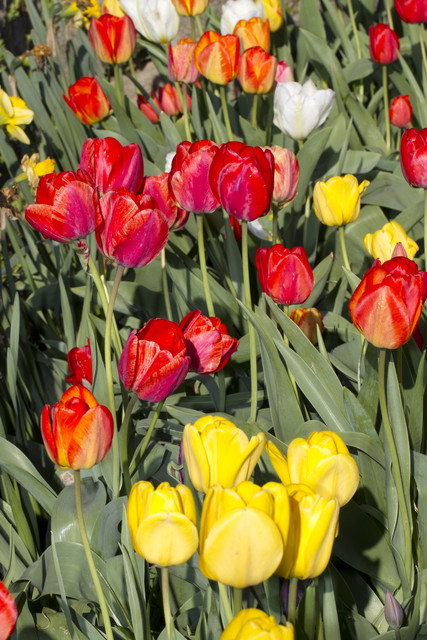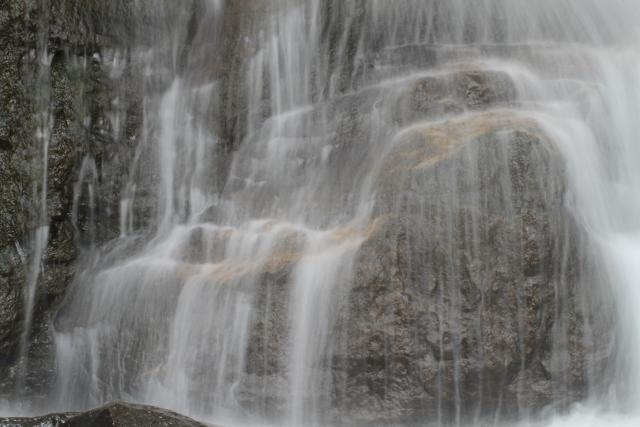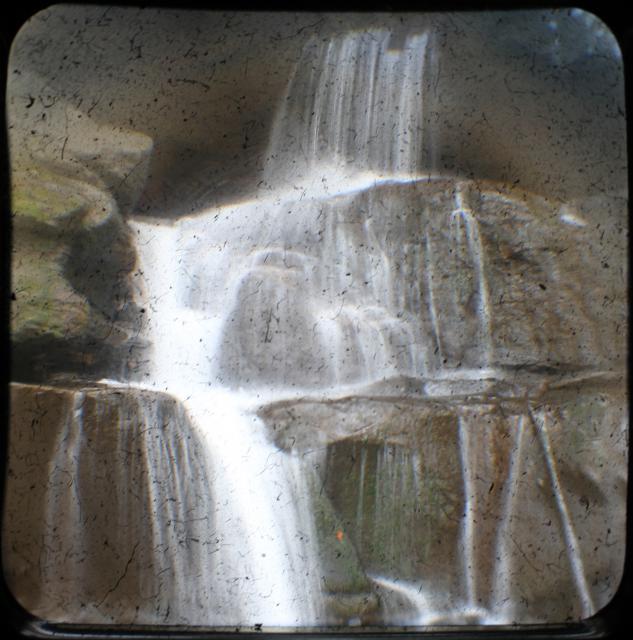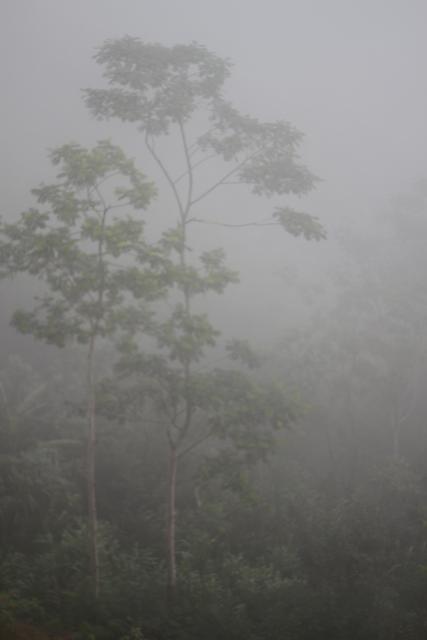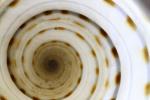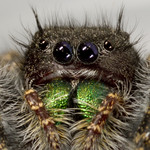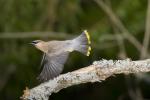Macro Quince
ktuli — Tue, 04/26/2011 - 21:13
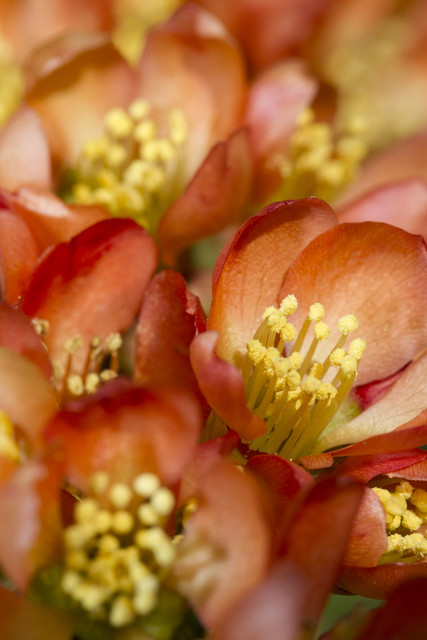
I suppose we'll continue the macro flower shots
I shared another shot of quince blossoms from last spring. This year, I used my new flash and 100mm f/2.8L macro lens to get in a lot closer to blossoms.
Technical Data: Canon EOS 7D, Canon EF 100mm f/2.8L Macro IS USM, 1/100 sec at f/11. Canon Speedlight 580EX II flash in auto mode. Image Stabilization on. ISO 200. RAW processing in Adobe Camera Raw.
Why This Photo: More macro and new flash work.
What Works: The tack sharp focus on the pollen covered stamens is a nice balance with the blurred foreground and background produced by the fairly shallow depth of field. Also, having the in-focus blossom off-centered in the shot is appealing. The entire shot being filled with blossoms prevents there being distracting elements in the frame.
What Doesn't Work: The in-focus blossom breaks the edge of the frame, and ideally should have been kept within the frame. Additionally, the bottom edge of the frame is somewhat darker than the rest - perhaps due to a slightly mis-aimed flash.
I really like bright orange color that pervades this entire shot. On top of that, the very close look at a small flower that could easily be overlooked provides a nice illustration of a tiny pattern in nature.
What do you think?
- Bill
Macro Tulip
ktuli — Mon, 04/25/2011 - 20:50
So with another break in the rain today, I decided to take the camera and my new flash (more on that soon) and flash bracket out and see what else I could get. I find tulips hard to shoot singly as their size proportions just make them difficult to capture. So I decided to aim the flash flight inside the flower and work on a macro view.
Technical Data: Canon EOS 7D, Canon EF 100mm f/2.8L Macro IS USM, 1/13 sec at f/16. Canon Speedlight 580EX II flash in auto mode and wireless control. Image Stabilization on. ISO 200. RAW processing in Adobe Camera Raw.
Why This Photo: Honestly, I was just playing with the new flash in wireless mode and seeing how well the flash bracket worked. Well, that and what I said above about tulips being hard to shoot.
What Works: The bright colors seem to pop, and the placement of the stigma and stamen off-center is nice. The focus resting right on those pollen covered stamen provides a good counter balance with their rough surface compared to the smooth petals of the tulip.
What Doesn't Work: Because of the flash, the reflection of the red color from the flower is picked up on the stigma (the center piece of the flower). Additionally, the right edge of the frame has part of the petal curling back into the shot - with the depth of field it is fairly blurred, but still is a little distracting.
Drop me a line and let me know what you think.
- Bill
Spring Color
ktuli — Sat, 04/23/2011 - 21:55
Just stopping by to share some spring color.
Technical Data: Canon EOS 7D, Canon EF 100mm f/2.8L Macro IS USM, 1/120 sec at f/16. Canon Speedlight 580EX II flash in auto mode. Image Stabilization on. ISO 200. RAW processing in Adobe Camera Raw.
Hopefully this will be a regular sight... if only all those April showers would give us a break.
- Bill
Feeding Orange Butterfly
ktuli — Wed, 04/20/2011 - 20:33
I have to admit that this photo is a bit old and actually dates back to when I had no clue what I was doing and was shooting in one of the auto-modes. However, I feel we need something with a little color since the last few have been somewhat drab. With spring finally setting up shop, shots like this will hopefully be more frequently.
Technical Data: Canon EOS Digital Rebel XT, Tamron 180mm f/3.5 Di SP LD 1:1 Macro, 1/320 sec at f/4.5. ISO 400. No post production. Franklin Park Conservatory, Columbus, OH.
Why This Photo: What can I say? I like macro photography, and butterflies make interesting macro subjects.
What Works: A shallow depth of field produces a nicely blurred background, while keeping the camera parallel to the wings of the butterfly keeps them in relatively good clarity. Also, the focus is sharp on the eyes of the butterfly, and a diagonal composition nicely balances the orange butterfly with the green plants.
What Doesn't Work: The antenna breaks the top of the frame, and the depth of field is a bit too shallow to keep the tips of the antenna in clarity.
I also have to apologize that I don't know the species of this butterfly, and I'm feeling a little lazy tonight, so I don't have my normal species information.
I'm just looking forward to getting out and capturing more spring macros soon!
- Bill
McConnell's Mill Waterfall with Macro
ktuli — Tue, 04/19/2011 - 19:25
Normally, you wouldn't use a 100mm macro lens to photograph a waterfall. Most times, if you're standing at the base of a waterfall, you reach into your bag and pull out a wide angle lens to capture the whole scene.
However, a couple weeks ago, I decided to try a longer focal length to get a more intimate view of only a portion of the waterfall. This is the result...
Technical Data: Canon EOS 7D, Canon EF 100mm f/2.8L Macro IS USM, 1 sec at f/32. Image Stabilization on. ISO 200. No post production.
Why This Photo: I have been to this waterfall several times so far, and I decided I wanted to find a different shot to come back with. Along with the TTV waterfall shots, I decided to isolate only a portion of the falls - to concentrate on the look of water cascading over the rough stone surface.
What Works: The slow shutter speed produced a nice soft look to the flowing water, while the sharp focus on the rock texture provides the nice juxtaposition between the two - particularly with the large portion of rock only partially obscured by the water in the bottom right corner.
What Doesn't Work: There is a small rock protruding into the frame in the bottom left corner. Additionally, the flow of the water is not as strong on the left edge of the frame. Perhaps a slightly tighter crop would eliminate these problems.
Drop me a comment and let me know what you think.
- Bill
Poll: Claytonia caroliniana
ktuli — Mon, 04/11/2011 - 19:40
Well, I've been on the fence about shooting RAW for a little while now. I've heard some a great deal number of sources that I really should. My reluctance stems from not really liking to have to do too much post production work. I really like to get my shots right in camera and not mess with things after the fact.
But this past weekend, I captured some shots in both RAW and JPG formats so I could start comparing them to see what I preferred. Take a look and let me know what you think...
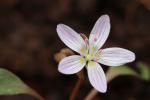 JPG Straight out of the Camera |
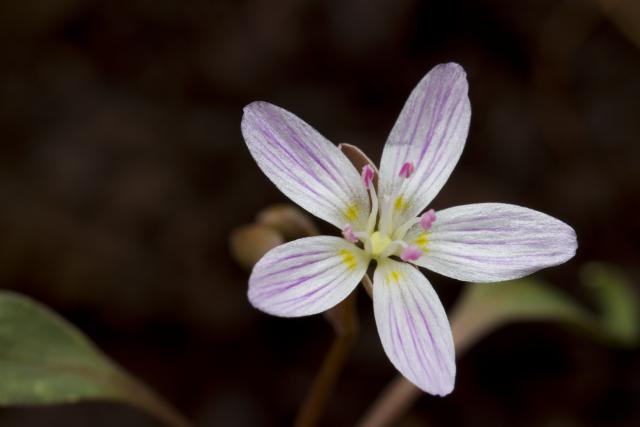 |
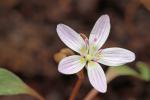 JPG w/ Auto-Smartfix from PSE8 |
|
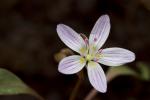 RAW w/ Brightness +50, Contrast +40, Sharpening 25 |
Technical Data: Canon EOS 7D, Canon EF 100mm f/2.8L Macro IS USM, 1/13th sec at f/11. Image Stabilization on. ISO 200. Post production as noted. Powdermill Nature Reserve, Rector, PA.
In case you're wondering, the flower is a Claytonia carolinana. They are tiny little flowers - probably in the range of 1/2 to 3/4 inch in size - and are some of the early bloomers each spring. I had been to Powdermill a couple weeks earlier, but it was cold the night before and there were no flowers to be found. I made a return trip this weekend and found many of them scattered all over (if you looked closely enough!). I searched around for a good specimen to shoot (most times, the flower faced downwards), and actually ended up accidentally uprooting it while trying to clear some debris around it - I relocated it, replanted it, and took the shots I wanted.
Oddly enough, I specifically remember "under-exposing" this image in the field. The camera kept wanting to meter the scene brighter to get the details in that dirt background, and I specifically wanted to avoid that so that I could maintain as much detail in those white petals as possible. Yet, when I looked at the JPG, it still looked bright and washed-out. Then when I ran it through the Auto Smart-Fix function in Photoshop Elements 8, it made that background even brighter still!
I will be honest, I have no clue what settings I should have chose for the Brightness and Contrast when converting the RAW file to JPG, but I simply slid things along until it looked like I remembered it looking in the field. Probably a little more aggressive than it really was, but that's ok. I had wanted the background dark, and I think the RAW file achieves that. I still have some learning to do to figure out what to do with the RAW conversion.
But for now, place your vote for which version you think looks the nicest.
Thanks for stopping by!
- Bill
TTV: McConnell's Mills Waterfall
ktuli — Wed, 04/06/2011 - 20:49
Ok - got another TTV shot for you today. This was the first time I'd taken the TTV rig anywhere other than Phipps, so it was kind of fun. Trying to scramble up the rocky hillside to this waterfall while juggling my camera bag, my DSLR, tripod, TTV rig, and monopod on the other hand was not so much fun.
I really don't know why these photos have so much more grit and grain to them than previous examples. It possibly could be because of the difference in focal distances - most of the TTV done at Phipps is done within a couple feet of the subject, here I was working in the tens of feet.
I also found that focusing was much more difficult this time around. I had a razor thin range on the lens that would put the scene into focus, and even then it was just a touch away from focusing purely on the grit and grain on the Argus' viewfinder lens.
Regardless, here's another shot I brought back on Sunday...
Technical Data: Canon EOS 7D TTV Argus Seventy-Five, Tokina AT-X M35 Pro DX AF 35mm f/2.8 Macro 1:1, 1/5 sec at f/8. ISO 200. Monopod and handheld. Cropped in Photoshop CS5 Extended.
Why This Photo: I've shot this waterfall before and I thought that since I was at the park for a field workshop for my class, that I would give it the TTV treatment to change things up instead of coming back with the same shot again.
What Works: The curving path of waterfall is pleasing to me, while the slow shutter speed produces that nice soft fluffy water.
What Doesn't Work: The grit and grain is just too distracting this time around I think - perhaps I need to clean up the viewfinder a little. Additionally, that razor thing focus range means that this shot is a little soft. And the long shutter speed to draw out the detail in the rocks produces a completely white stream of water that is a bit overpowering.
Even with its flaws, I still really like the shot, and may be convinced to head back in the summer with a different TLR (perhaps the Anscoflex II) and try it again.
Drop me a comment and let me know what you think!
- Bill
TTV: McConnell's Mill Covered Bridge
ktuli — Tue, 04/05/2011 - 20:05
Technical Data: Canon EOS 7D TTV Argus Seventy-Five, Tokina AT-X M35 Pro DX AF 35mm f/2.8 Macro 1:1, 1/16 sec at f/9.1. ISO 200. Monopod and handheld. Cropped in Photoshop CS5 Extended.
I'm busy with some other stuff tonight, so you'll have to provide your own critique. Thanks for stopping by.
- Bill
Bali: Trees in the Clouds
ktuli — Sat, 04/02/2011 - 20:31
It was the rainy season while we were in Bali, and as such, it rained at least once every day.
In particular, on our second day there, we made a trip up to see one of the major volcanoes on the island (sorry - I can't remember the name). We seemed to have good luck with the rain only hitting overnight or while we were in the van driving to/from our destinations.
However, in this particular case, the rain produces a large amount of mist/fog that just blanketed the whole area. We had driven up a neighboring peak so that we could enjoy a lunch with a scenic vista of the volcano right across thre way, but were presented with nothing but a featureless white cloud.
As we finished eating, I watched the fog shift and pulse as it started to lift slightly. We spent a while on the overlook catching glimpses of the volcano. At one point, these trees appeared through the fog. I instantly thought it looked like something I would see in a National Geographic magazine or a BBC Wildlife special.
I quickly composed the shot, and fired off one frame, and just as quickly as they appeared, the trees were gone.
Technical Data: Canon EOS 7D, Canon EF 50mm f/1.8 II, 1/660th sec at f/1.8, ISO 100 (auto). No post production
- Bill
Wakatobi: Pair of Hawkfish
ktuli — Thu, 03/31/2011 - 20:20
Just stopping by to share a couple different hawkfish we encountered while diving in Wakatobi. Enjoy.
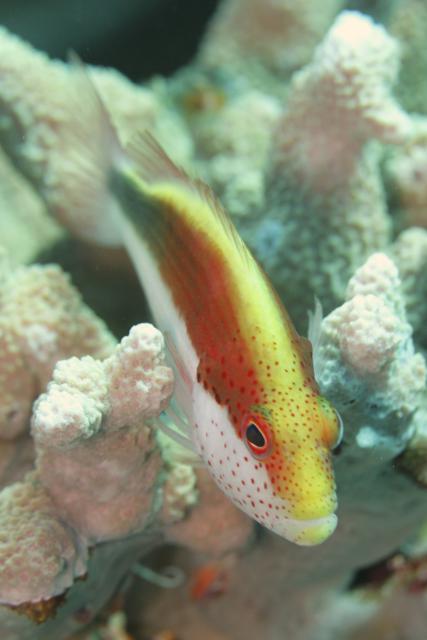
Freckled Hawkfish (Paracirrhites forsteri)
Technical Data: Canon EOS 7D, Canon EF 100mm f/2.8L Macro IS USM, 1/100th sec at f/8. Image Stabilization on. ISO 400 (Auto). Ikelite Housing and Port with Ikelite DS161 Strobe in TTL Mode. Remove color cast and cropped in Photoshop Elements 8.0.
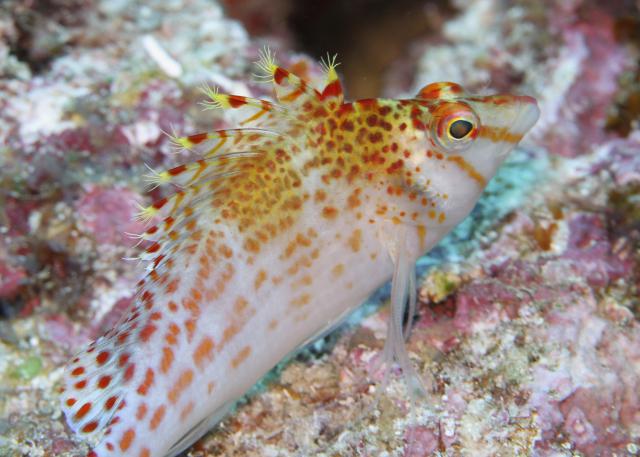
Dwarf Hawkfish (Cirrhitichthys falco)
Technical Data: Canon EOS 7D, Canon EF 100mm f/2.8L Macro IS USM, 1/40th sec at f/8. Image Stabilization on. ISO 400 (Auto). Ikelite Housing and Port with Ikelite DS161 Strobe in TTL Mode. Remove color cast and cropped in Photoshop Elements 8.0.
Some cool little fish, we saw plenty of them on the reefs - especially the dwarf hawkfish whose camouflage allows them to sit right out in the open.
- Bill


